Foreword / YouTube Video Review
This pair of speakers was loaned to me by their owner who had them drop shipped from a retailer.
The review on this website is a brief overview and summary of the objective performance of this speaker. It is not intended to be a deep dive. Moreso, this is information for those who prefer “just the facts” and prefer to have the data without the filler. The video below has more discussion with respect to the technical merits and subjective notes I had during my listening sessions.
For help understanding the data, I encourage you to watch this video which discusses the implications of (some of) the data shown below:
Information and Photos
Some specs from the manufacturer can be found here.
- SPL: 104 dB
- Amplifier Power: 72 W Bass (Class D) + 36 W Midrange (Class D) + 36 W Treble (Class D)
- Frequency Response: 45 Hz - 37 kHz ("-6 dB")
- Accuracy of Frequency Response: ± 1.5 dB (58 Hz - 20 kHz)
- Driver Dimensions: 2 x H 65 x W 130 mm Bass + ⌀ 90 mm Midrange + ⌀ 19 mm Treble (view in inches)
- Dimensions: H 305 x W 189 x D 212 mm, with Iso-Pod™ (view in inches)
- Weight: 6.7 kg / 14.8 lb
- Connections:
- 1 x XLR Analog Input
- 1 x XLR AES/EBU Input
- 1 x XLR AES/EBU Output
- 2 x RJ45 Control
Price is approximately $2250 USD for a single, or $4500 USD for a speaker pair (as of this writing).
Genelec provided me with this exploded view so you can get a better idea of the parts and complexity of this speaker.
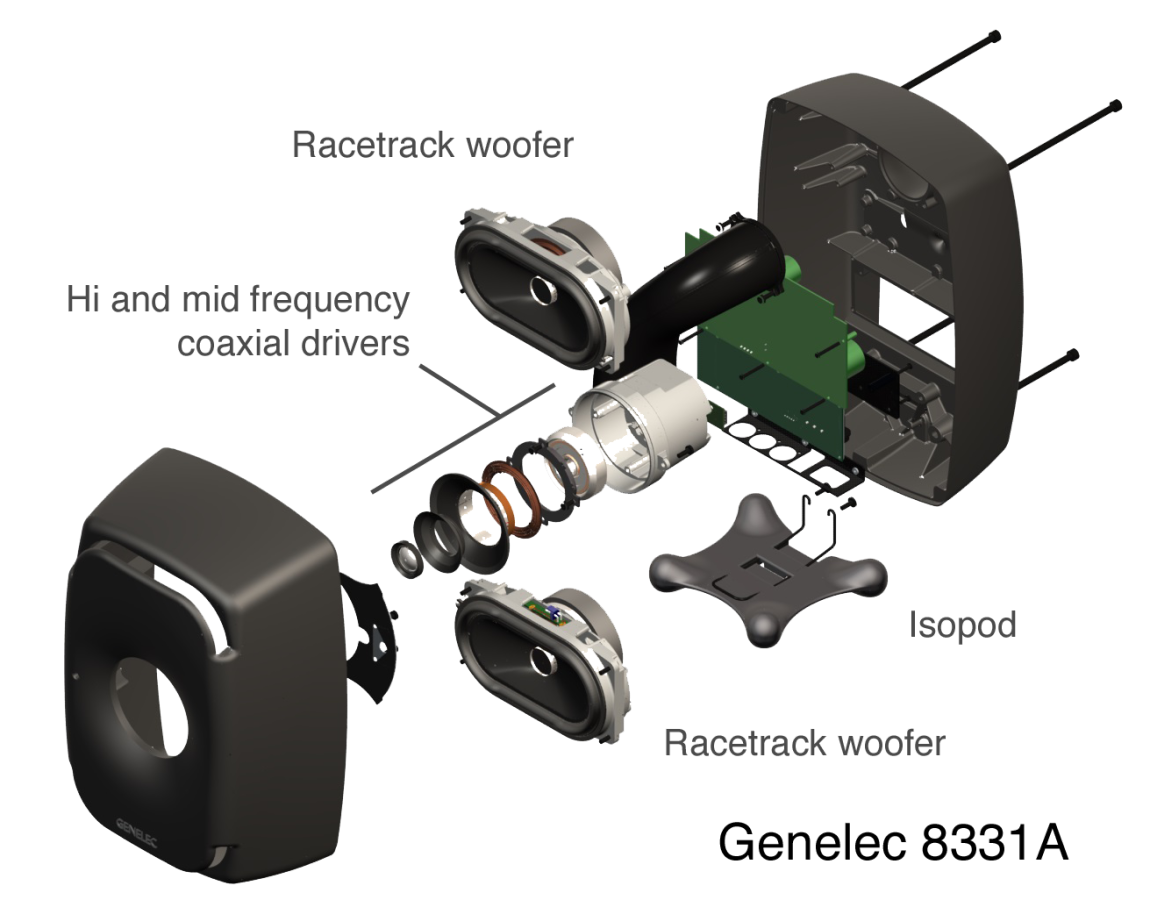
CTA-2034 (SPINORAMA) and Accompanying Data
All data collected using Klippel’s Near-Field Scanner. The Near-Field-Scanner 3D (NFS) offers a fully automated acoustic measurement of direct sound radiated from the source under test. The radiated sound is determined in any desired distance and angle in the 3D space outside the scanning surface. Directivity, sound power, SPL response and many more key figures are obtained for any kind of loudspeaker and audio system in near field applications (e.g. studio monitors, mobile devices) as well as far field applications (e.g. professional audio systems). Utilizing a minimum of measurement points, a comprehensive data set is generated containing the loudspeaker’s high resolution, free field sound radiation in the near and far field. For a detailed explanation of how the NFS works and the science behind it, please watch the below discussion with designer Christian Bellmann:
The reference plane in this test is between the tweeter.
All dip switches were set to “off”.
Measurements are provided in a format in accordance with the Standard Method of Measurement for In-Home Loudspeakers (ANSI/CTA-2034-A R-2020). For more information, please see this link.
CTA-2034 / SPINORAMA:
The On-axis Frequency Response (0°) is the universal starting point and in many situations it is a fair representation of the first sound to arrive at a listener’s ears.
The Listening Window is a spatial average of the nine amplitude responses in the ±10º vertical and ±30º horizontal angular range. This encompasses those listeners who sit within a typical home theater audience, as well as those who disregard the normal rules when listening alone.
The Early Reflections curve is an estimate of all single-bounce, first-reflections, in a typical listening room.
Sound Power represents all of the sounds arriving at the listening position after any number of reflections from any direction. It is the weighted rms average of all 70 measurements, with individual measurements weighted according to the portion of the spherical surface that they represent.
Sound Power Directivity Index (SPDI): In this standard the SPDI is defined as the difference between the listening window curve and the sound power curve.
Early Reflections Directivity Index (EPDI): is defined as the difference between the listening window curve and the early reflections curve. In small rooms, early reflections figure prominently in what is measured and heard in the room so this curve may provide insights into potential sound quality.

Early Reflections Breakout:
Floor bounce: average of 20º, 30º, 40º down
Ceiling bounce: average of 40º, 50º, 60º up
Front wall bounce: average of 0º, ± 10º, ± 20º, ± 30º horizontal
Side wall bounces: average of ± 40º, ± 50º, ± 60º, ± 70º, ± 80º horizontal
Rear wall bounces: average of 180º, ± 90º horizontal

Estimated In-Room Response:
In theory, with complete 360-degree anechoic data on a loudspeaker and sufficient acoustical and geometrical data on the listening room and its layout it would be possible to estimate with good precision what would be measured by an omnidirectional microphone located in the listening area of that room. By making some simplifying assumptions about the listening space, the data set described above permits a usefully accurate preview of how a given loudspeaker might perform in a typical domestic listening room. Obviously, there are no guarantees, because individual rooms can be acoustically aberrant. Sometimes rooms are excessively reflective (“live”) as happens in certain hot, humid climates, with certain styles of interior décor and in under-furnished rooms. Sometimes rooms are excessively “dead” as in other styles of décor and in some custom home theaters where acoustical treatment has been used excessively. This form of post processing is offered only as an estimate of what might happen in a domestic living space with carpet on the floor and a “normal” amount of seating, drapes and cabinetry.
For these limited circumstances it has been found that a usefully accurate Predicted In-Room (PIR) amplitude response, also known as a “room curve” is obtained by a weighted average consisting of 12 % listening window, 44 % early reflections and 44 % sound power. At very high frequencies errors can creep in because of excessive absorption, microphone directivity, and room geometry. These discrepancies are not considered to be of great importance.

Horizontal Frequency Response (0° to ±90°):

Vertical Frequency Response (0° to ±40°):

Horizontal Contour Plot (normalized):
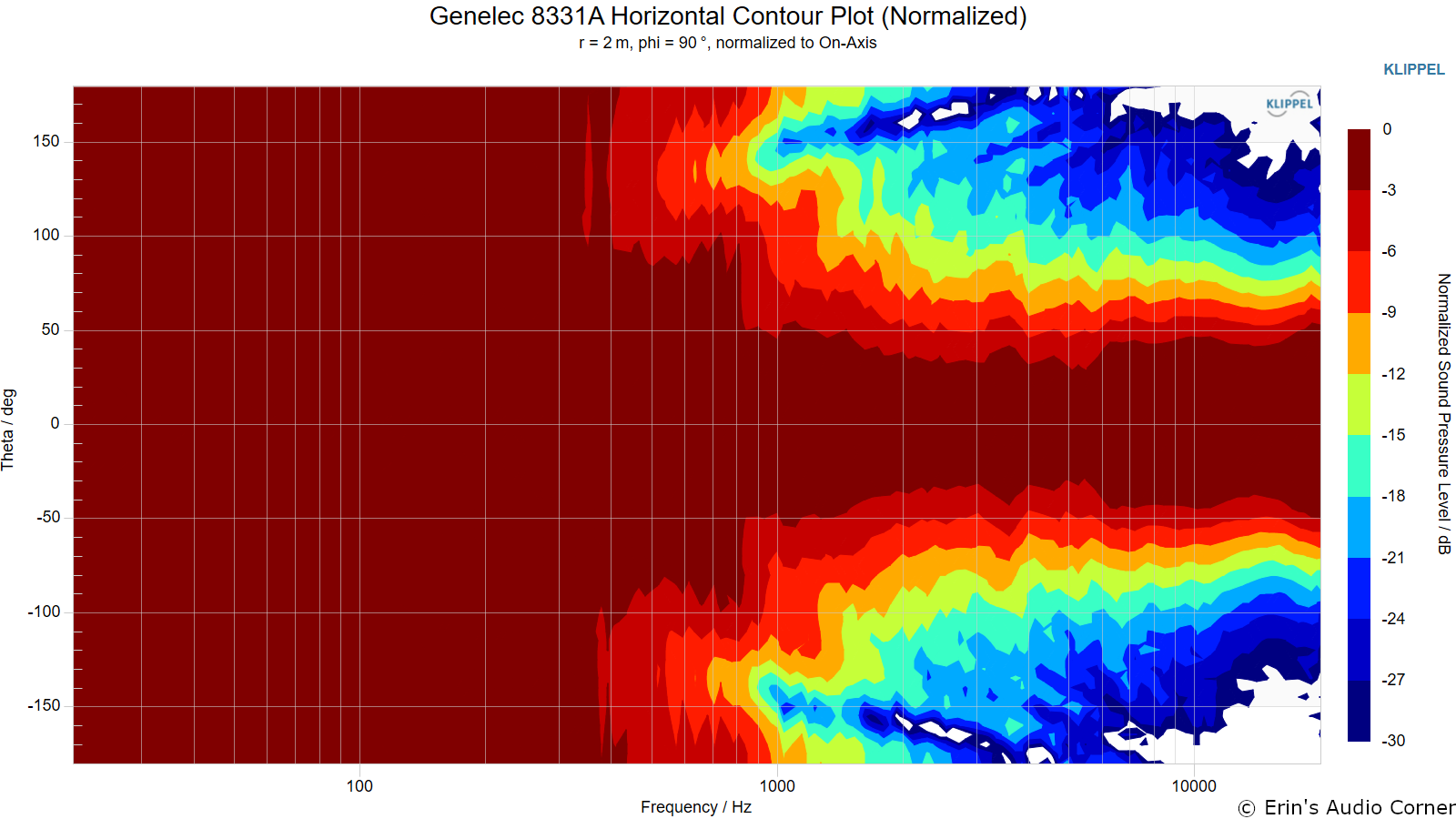
Vertical Contour Plot (normalized):
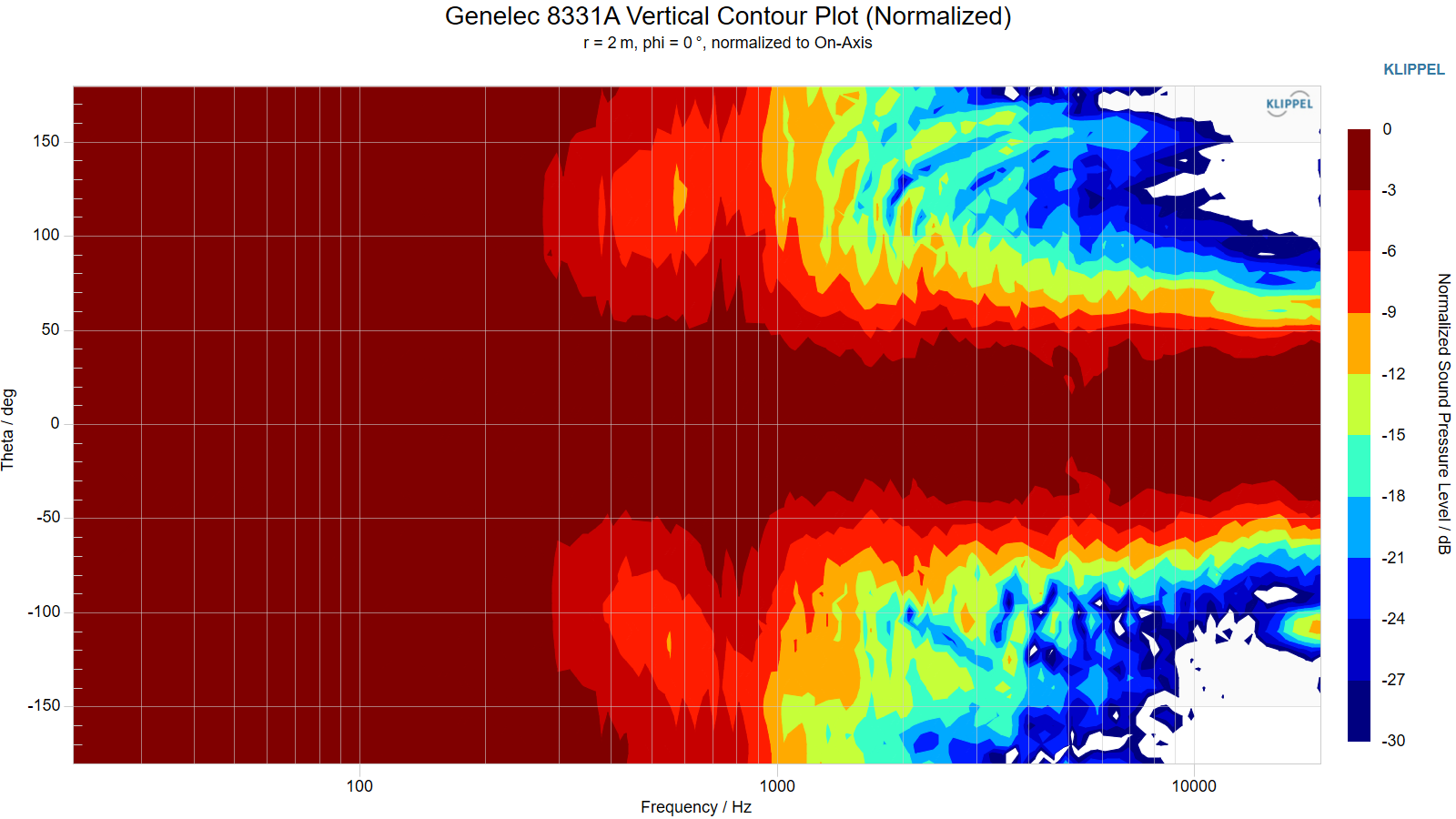
“Globe” Plots
Horizontal Polar (Globe) Plot:
This represents the sound field at 2 meters - above 200Hz - per the legend in the upper left.
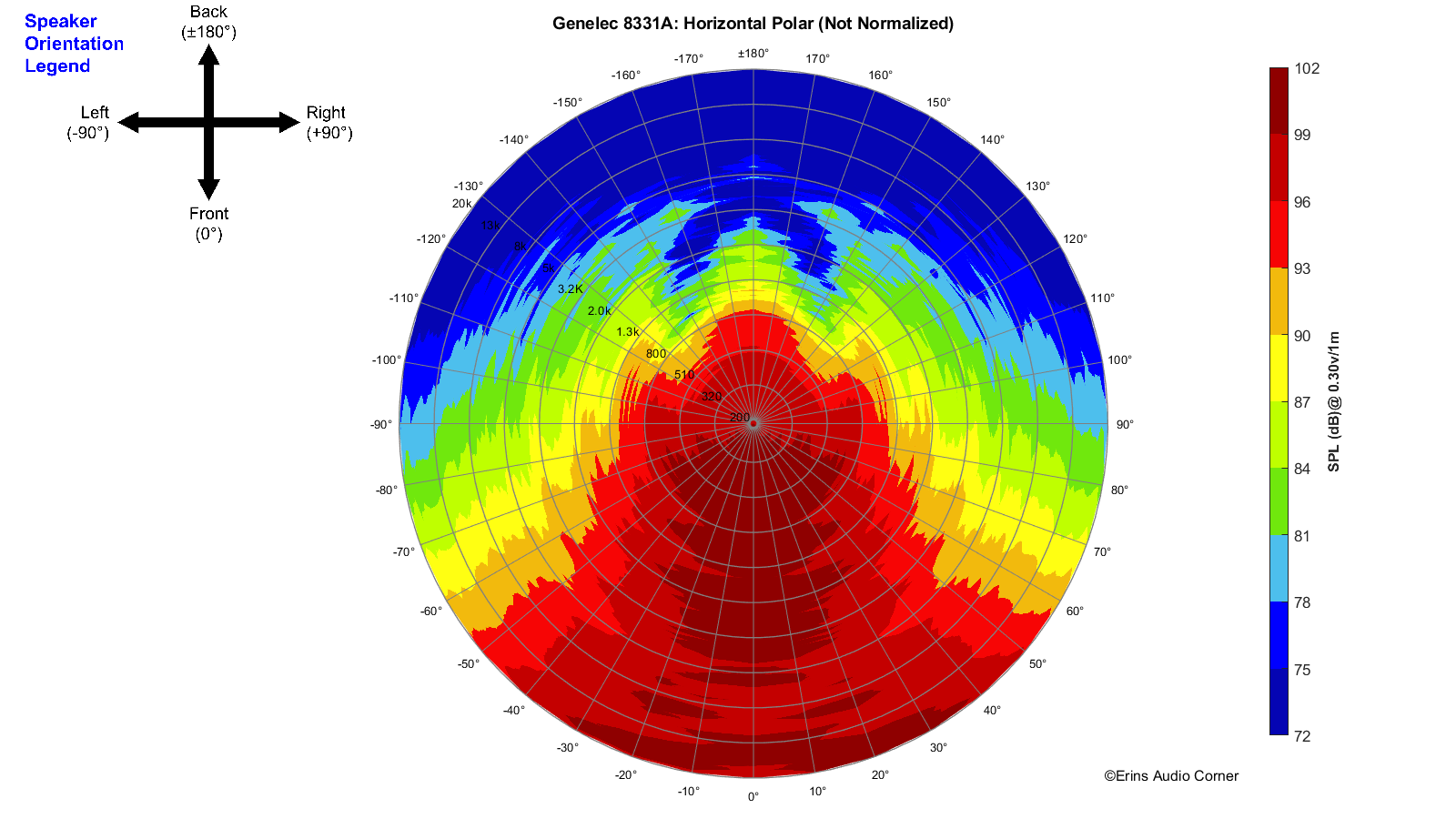
Vertical Polar (Globe) Plot:
This represents the sound field at 2 meters - above 200Hz - per the legend in the upper left.
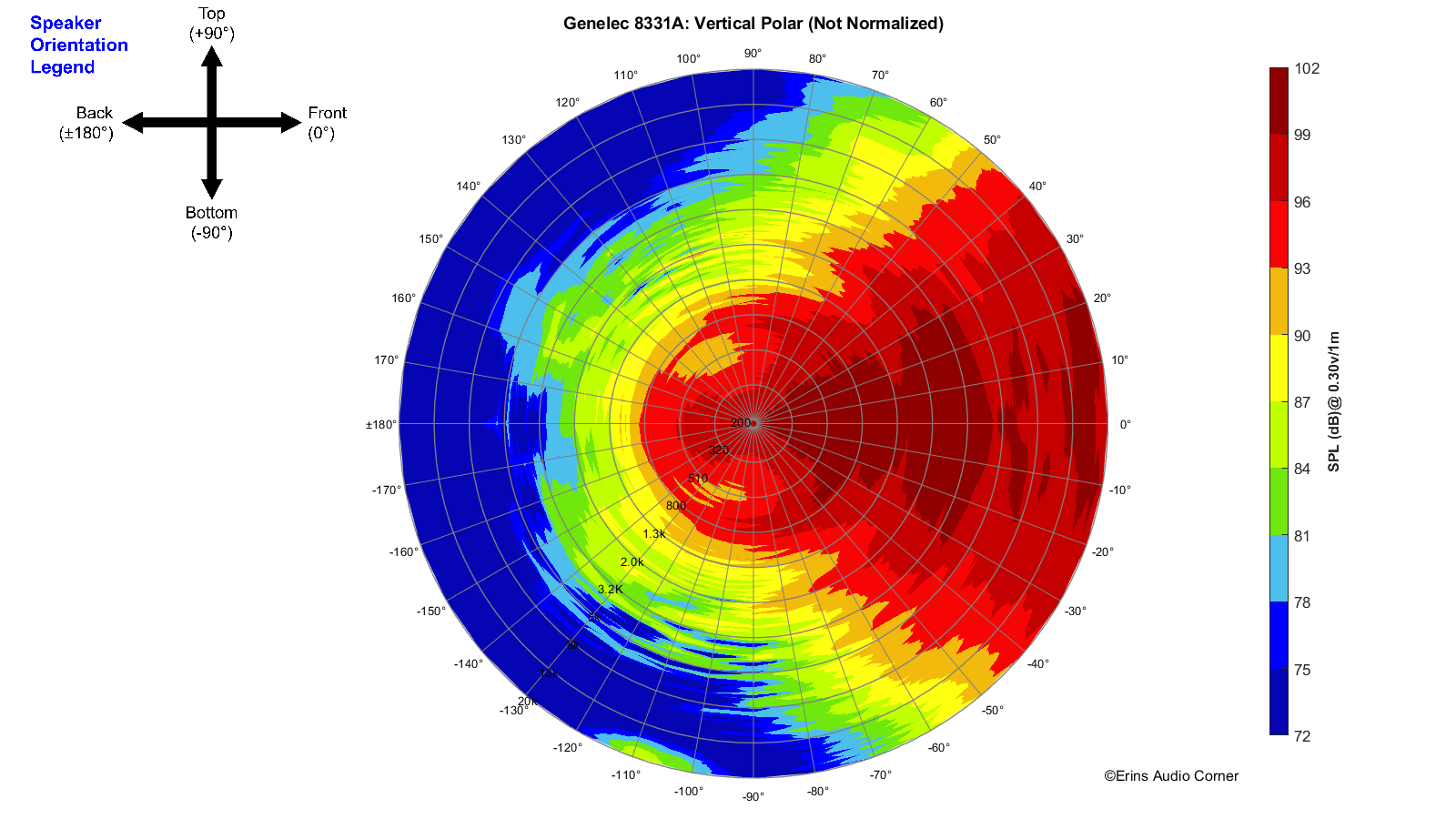
Additional Measurements
Step Response
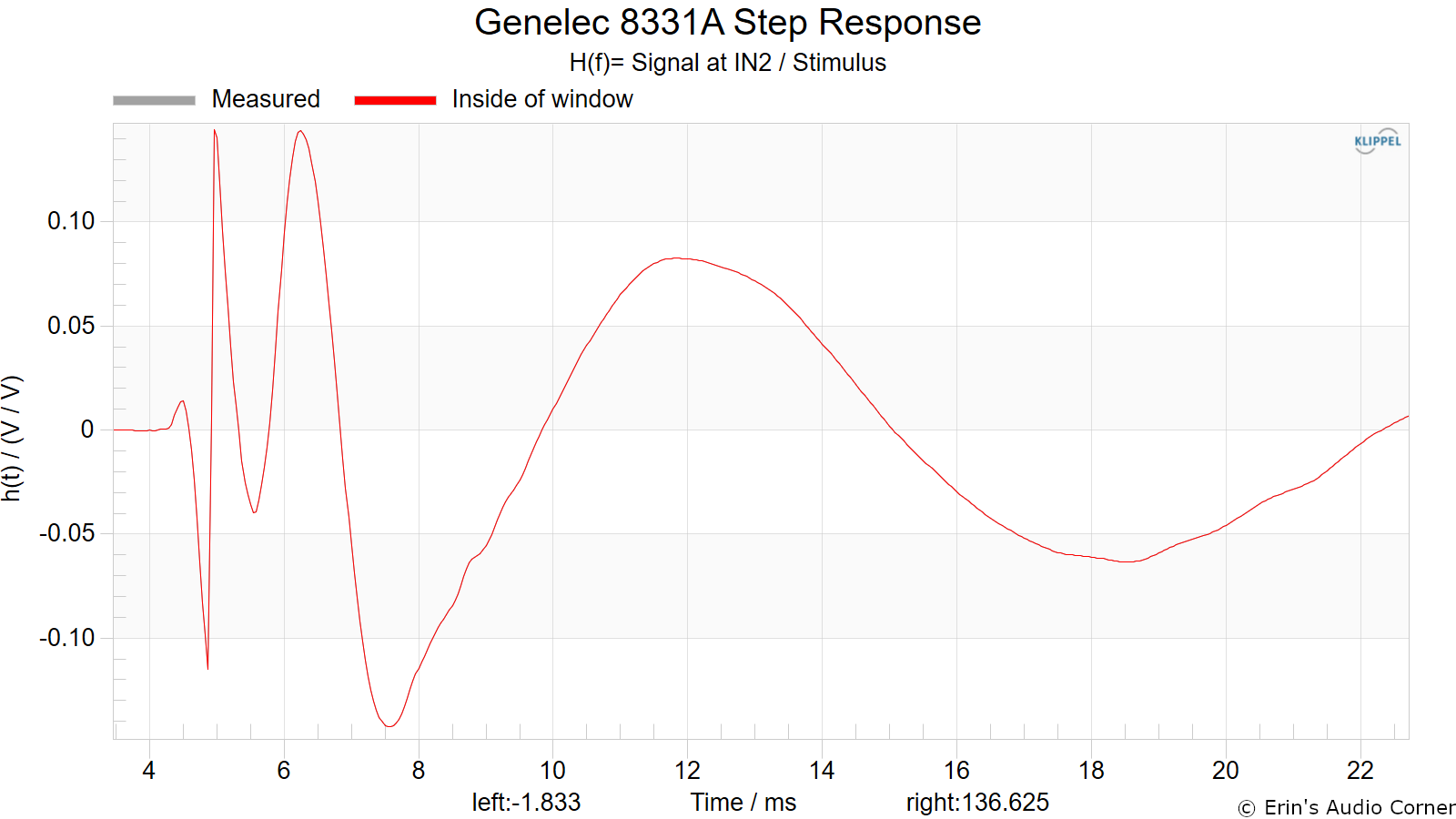
Group Delay
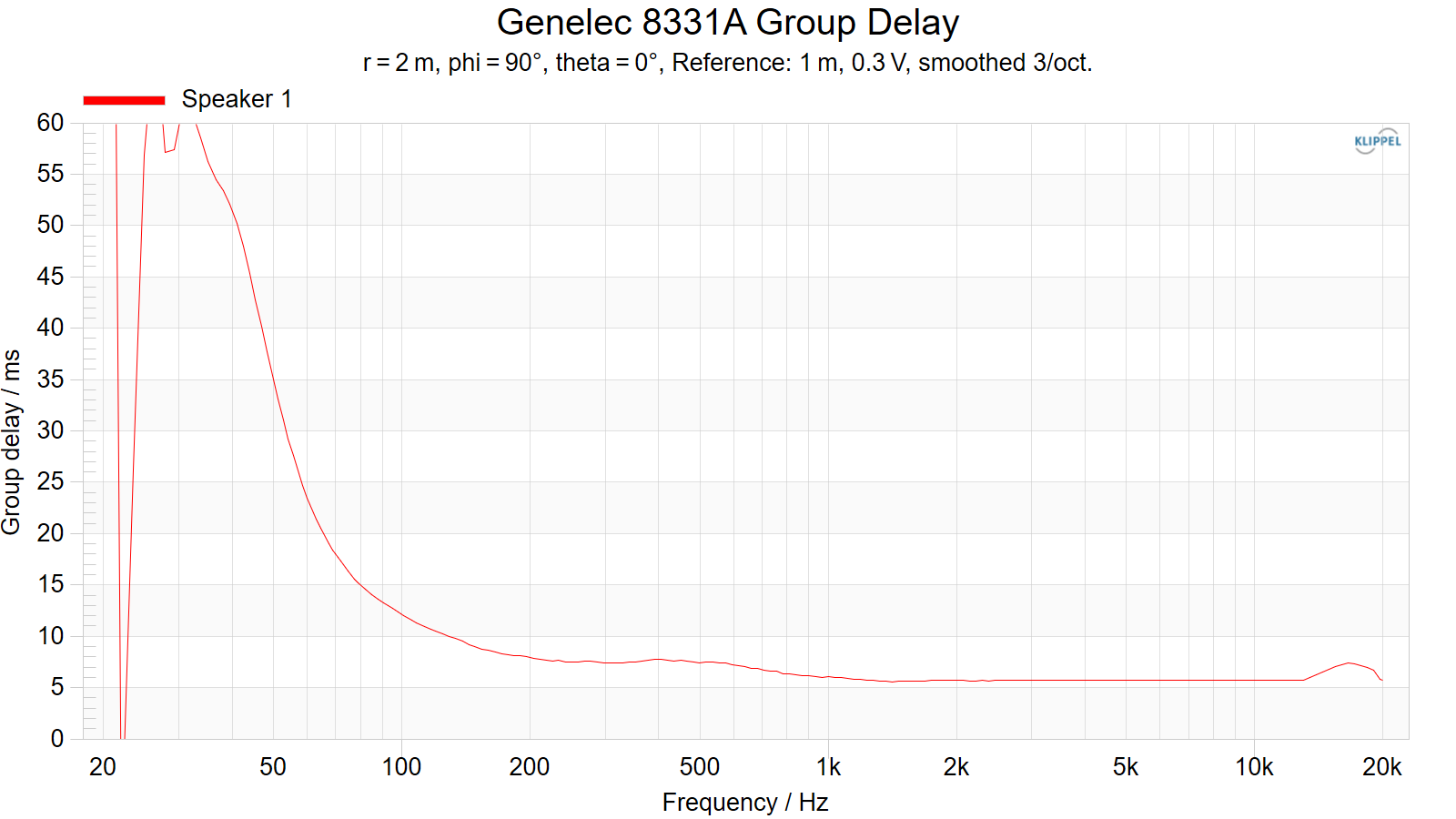
Harmonic Distortion
Harmonic Distortion at 86dB @ 1m:
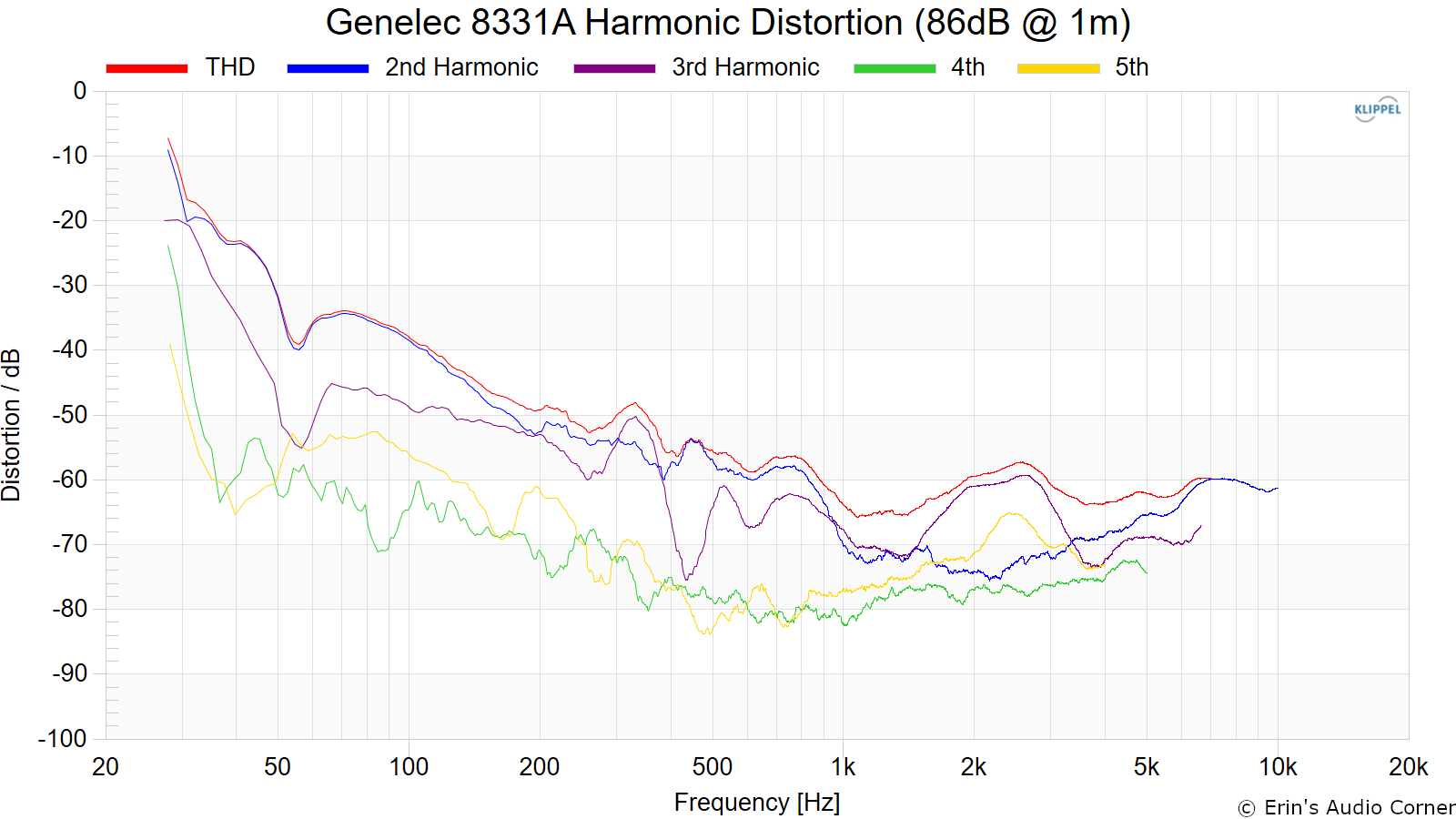
Harmonic Distortion at 96dB @ 1m:
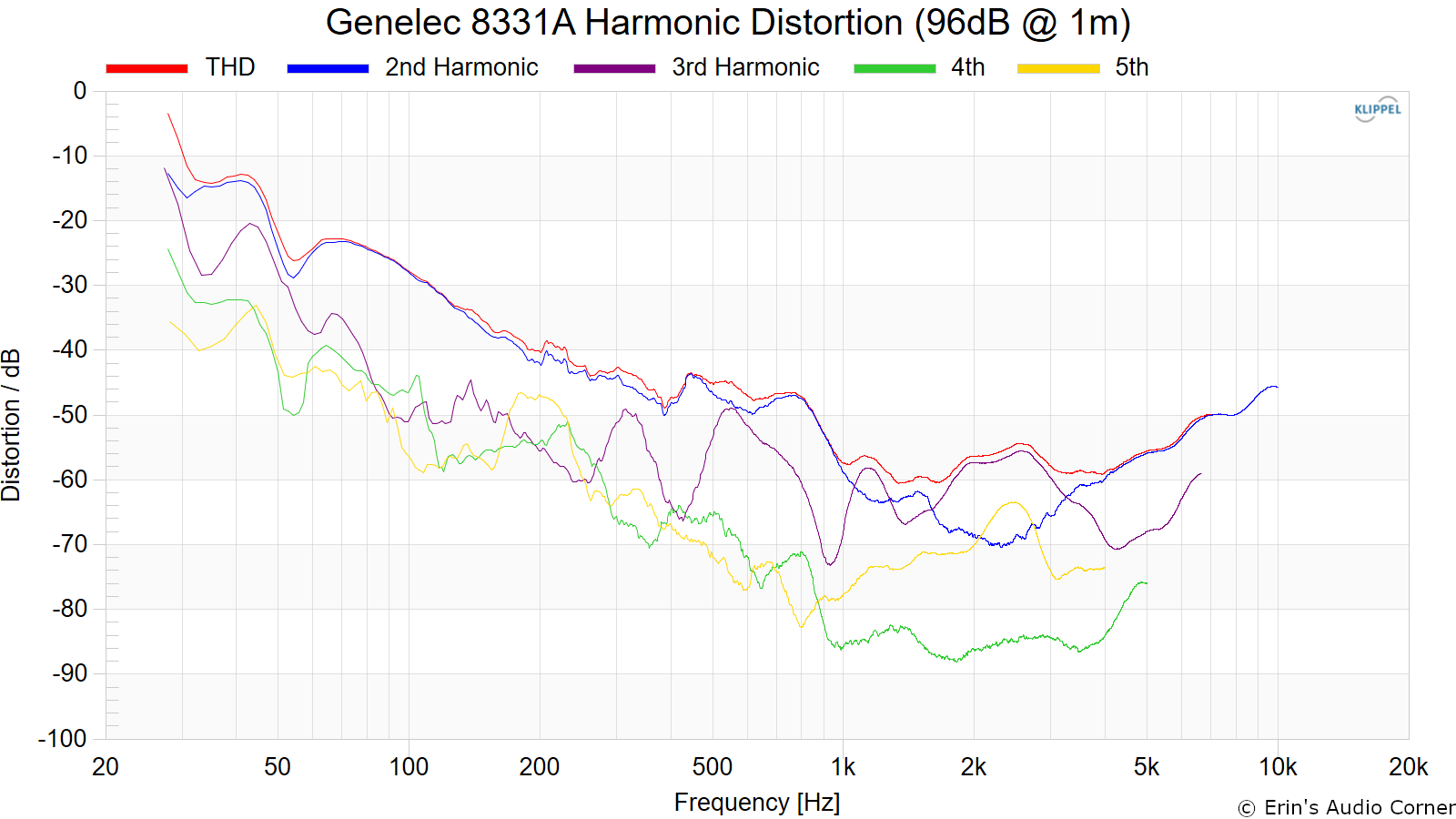
Dynamic Range (Instantaneous Compression Test)
The below graphic indicates just how much SPL is lost (compression) or gained (enhancement; usually due to distortion) when the speaker is played at higher output volumes instantly via a 2.7 second logarithmic sine sweep referenced to 76dB at 1 meter. The signals are played consecutively without any additional stimulus applied. Then normalized against the 76dB result.
The tests are conducted in this fashion:
- 76dB at 1 meter (baseline; black)
- 86dB at 1 meter (red)
- 96dB at 1 meter (blue)
- 102dB at 1 meter (purple)
The purpose of this test is to illustrate how much (if at all) the output changes as a speaker’s components temperature increases (i.e., voice coils, crossover components) instantaneously.
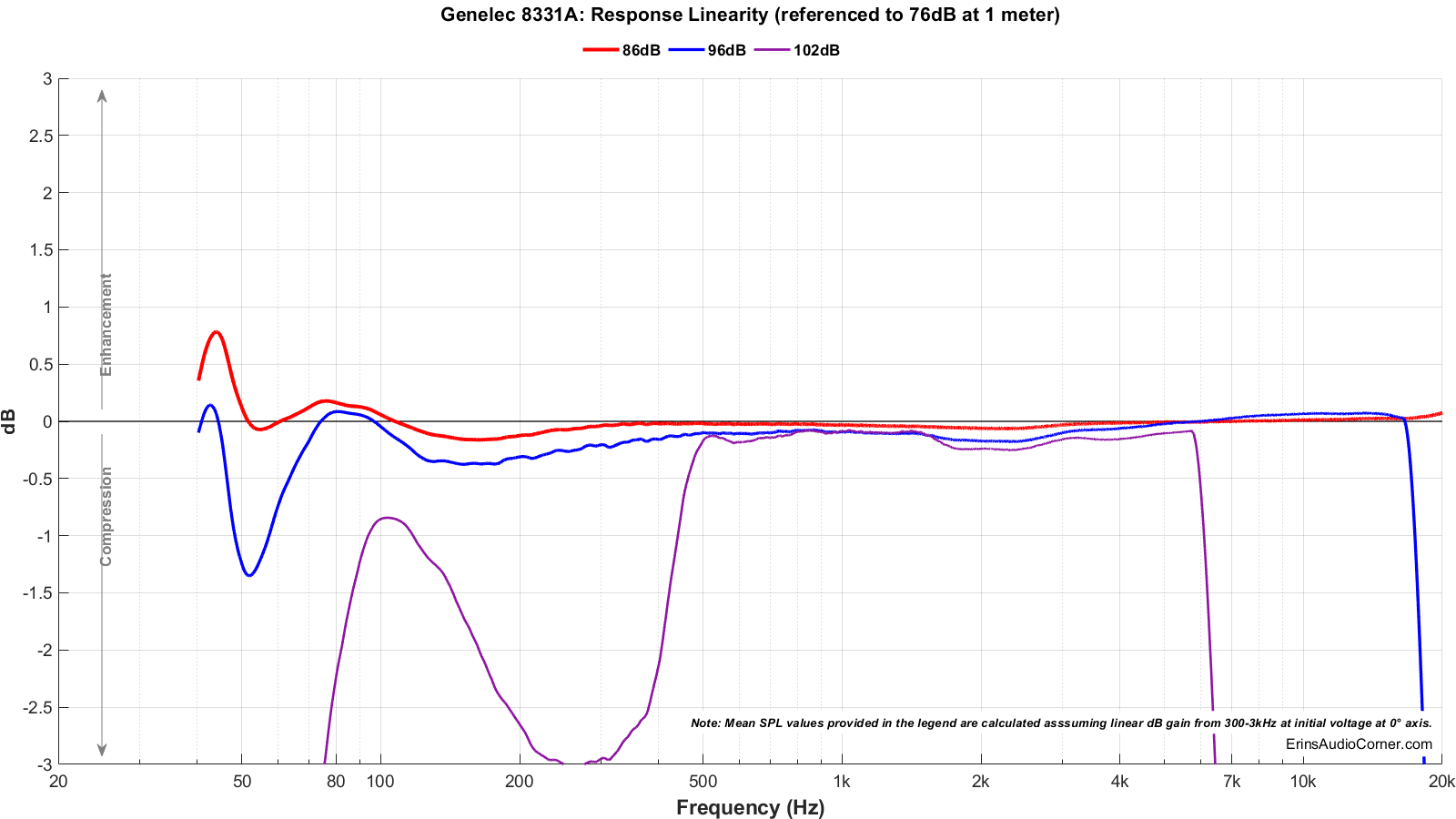
Parting / Random Thoughts
See video linked above for subjective and objective analysis. But just a couple notes regarding the compression testing because I know some will be perplexed by the results:
- The compression / limiting test results look crazy, don’t they? I thought so, too. So, I did some additional testing and I also reached out to Genelec to see if the results made sense to them. In my listening tests, when I ran the speaker well into clipping (solid red light on the front), the result was the speaker would mute itself. Not long term; just instantaneously. However, the only way I could get this to happen is when I was practically trying to break the speaker (good news, it didn’t break!). The data backs that up. When I performed the compression testing with sine sweeps what I saw and heard was this same thing. In other words, the protection system was designed to do this. And Genelec confirmed as much, per their reply below:
The protection system is designed to ensure long-term reliability. Allowing excessive temperature in the voice coils can significantly reduce lifetime and even cause rapid failure. Protection and driver characteristics have been selected so that for music and speech signals there is little or no need for protection. Other manufacturers may have different philosophy with protection, like lifting the low corner frequency of the woofer to slightly limit heating, resulting in thermal compression and ultimately failure. Some even boast of not using protection at all. We find that this may often lead to earlier than expected failure and harm for the user.
- In the room, I was able to push these to 100dB at 3m before the clipping indicator came on and began to mute the output to protect the speaker (per design). Realistically, this speaker will likely not be listened at this distance and likely will be listened to in the 1m to 2m distance. In this case, you would have higher dynamic range capability than I did at the 3m distance.
- The imaging of this speaker is superb. And in the nearfield, it’s even more noteworthy as most speakers with multiple drivers - not coincident - tend to not sum properly in the nearfield and you need to be further than a meter for that to occur (generally speaking, of course).
- F3 = 49Hz. F10 = 39Hz. The 8331A plays down into the 50Hz region just fine and in-room at 3m distance and 1 meter from each sidewall, they extended down to 40Hz before they rolled off sharply.
Support the Cause
If you find this review helpful and want to help support the cause there are a few ways you can do so below. Your support helps me pay for new items to test, hardware, miscellaneous items needed for testing and costs of the site’s server space and bandwidth. Any help is very much appreciated.
Join my Patreon: Become a Patron!
Or using my generic Amazon affiliate banner below to buy anything you may need - from toothpaste to Blu-Ray Discs - from Amazon, which helps me gain a small commission at no additional cost to you. Speaker wire is just the generic link I chose to provide.
You can also join my Facebook and YouTube pages if you’d like to follow along with updates.